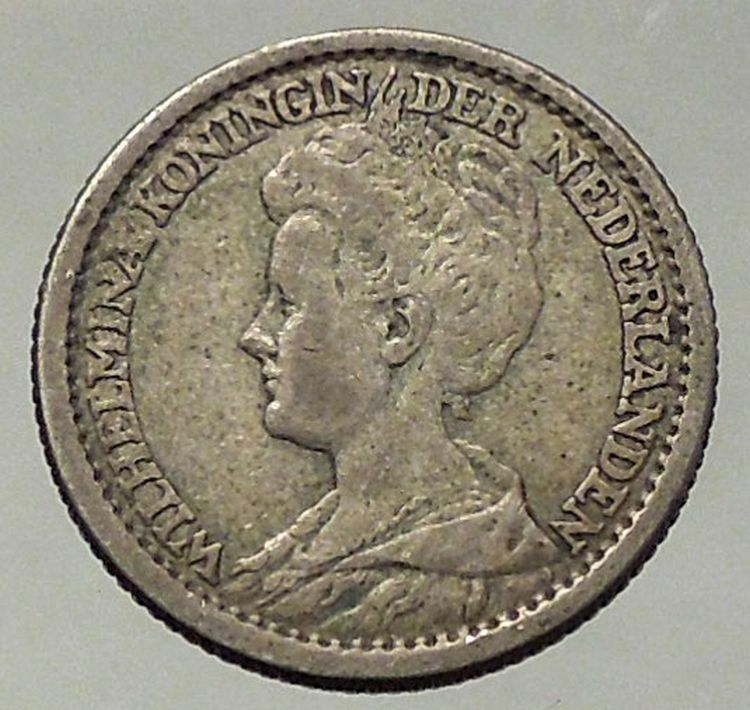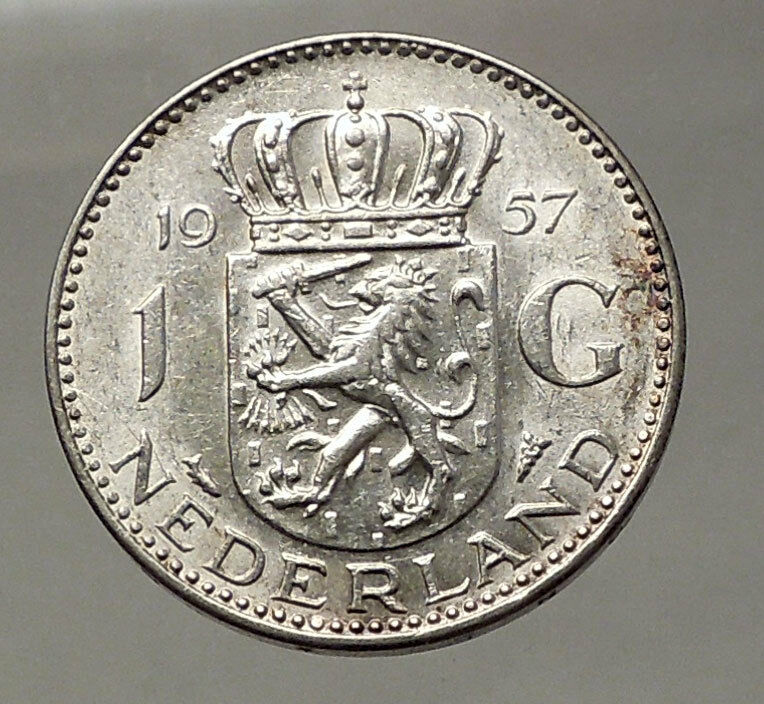|
Kingdom of Netherlands under Wilhelmina – Queen: November 1890 – 4 September 1948
1938 Silver 1 Gulden 28mm (9.90 grams) 0.720 Silver (0.230 oz. ASW)
Reference: KM# 161.1
WILHELMINA KONINGIN DER NEDERLANDEN, Small coat of arms of the Netherlands dividing value.
Privy mark (left) and mint mark (caduceus, right).
MUNT VAN HET KONINGRIJK DER NEDERLANDEN 1 G ··, Smooth with incused lettering.
Edge Lettering: GOD * ZIJ * MET * ONS *
You are bidding on the exact item pictured, provided with a Certificate of Authenticity and Lifetime Guarantee of Authenticity.
 Wilhelmina (Wilhelmina Helena Pauline Maria; 31 August 1880 – 28 November 1962) was Queen of the Kingdom of the Netherlands from 1890 to 1948. She reigned for nearly 58 years, longer than any other Dutch monarch. Her reign saw World War I and World War II , the economic crisis of 1933 , and the decline of the Netherlands as a major colonial power . Outside the Netherlands she is primarily remembered for her role in World War II, in which she proved to be a great inspiration to the Dutch resistance . Wilhelmina (Wilhelmina Helena Pauline Maria; 31 August 1880 – 28 November 1962) was Queen of the Kingdom of the Netherlands from 1890 to 1948. She reigned for nearly 58 years, longer than any other Dutch monarch. Her reign saw World War I and World War II , the economic crisis of 1933 , and the decline of the Netherlands as a major colonial power . Outside the Netherlands she is primarily remembered for her role in World War II, in which she proved to be a great inspiration to the Dutch resistance .
During the 1920s and 1930s, the Netherlands began to emerge as an industrial power. Engineers reclaimed vast amounts of land that had been under water by building the Zuiderzee Works. In 1934, both Wilhelmina’s mother Queen Emma and her husband, Prince Hendrik, died.
Most of the 1930s were also occupied by the need to find a suitable husband for Juliana. This was a difficult task since Wilhelmina was very religious, and insisted that her daughter’s hand be given to a Protestant of royal birth. Several prospects from the United Kingdom and Sweden either declined or were turned down by Juliana. Finally, Wilhelmina found a suitable match for her daughter in Prince Bernhard of Lippe-Biesterfeld, a German aristocrat. The marriage initially drew some controversy due to rumours that Bernhard was pro-Nazi. It was subsequently confirmed that he had indeed been a member of the Nazi Party and of the so-called Reiter-SS (SS Cavalry Corps), as was proved by the Dutch national institute for war documentation, NIOD.
In 1939, the government proposed a refugee camp near the city of Apeldoorn for German Jews fleeing the Nazi regime. Wilhelmina intervened, as she felt the planned location was “too close” to her summer residence. If indeed spies were to be among the fugitives, they would be within walking distance of Het Loo Palace. The camp was finally erected about 10 km from the village of Westerbork.
.svg/220px-Kingdom_of_the_Netherlands_(orthographic_projection).svg.png)  The Kingdom of the Netherlands, commonly known as the Netherlands, is a sovereign state and constitutional monarchy with territory in western Europe and in the Caribbean. The Kingdom of the Netherlands, commonly known as the Netherlands, is a sovereign state and constitutional monarchy with territory in western Europe and in the Caribbean.
 The four parts of the Kingdom – Aruba, Curaçao, Sint Maarten and the Netherlands – are constituent countries (landen in Dutch) and participate on a basis of equality as partners in the Kingdom. In practice, however, most of the Kingdom affairs are administered by the Netherlands – which comprises roughly 98% of the Kingdom’s land area and population – on behalf of the entire Kingdom. Consequently, the countries of Aruba, Curaçao, and Sint Maarten are dependent on the Netherlands for matters like foreign policy and defence, although they are autonomous to a certain degree with their own parliaments. The four parts of the Kingdom – Aruba, Curaçao, Sint Maarten and the Netherlands – are constituent countries (landen in Dutch) and participate on a basis of equality as partners in the Kingdom. In practice, however, most of the Kingdom affairs are administered by the Netherlands – which comprises roughly 98% of the Kingdom’s land area and population – on behalf of the entire Kingdom. Consequently, the countries of Aruba, Curaçao, and Sint Maarten are dependent on the Netherlands for matters like foreign policy and defence, although they are autonomous to a certain degree with their own parliaments.
The vast majority in land area of the constituent country of the Netherlands (as well as the Kingdom) is located in Europe, with the exception of the Caribbean Netherlands: its three special municipalities (Bonaire, Saba, and Sint Eustatius) that are located in the Caribbean. The constituent countries of Aruba, Curaçao, and Sint Maarten are located in the Caribbean as well.
|





 Wilhelmina (Wilhelmina Helena Pauline Maria; 31 August 1880 – 28 November 1962) was Queen of the Kingdom of the Netherlands from 1890 to 1948. She reigned for nearly 58 years, longer than any other Dutch monarch. Her reign saw World War I and World War II , the economic crisis of 1933 , and the decline of the Netherlands as a major colonial power . Outside the Netherlands she is primarily remembered for her role in World War II, in which she proved to be a great inspiration to the Dutch resistance .
Wilhelmina (Wilhelmina Helena Pauline Maria; 31 August 1880 – 28 November 1962) was Queen of the Kingdom of the Netherlands from 1890 to 1948. She reigned for nearly 58 years, longer than any other Dutch monarch. Her reign saw World War I and World War II , the economic crisis of 1933 , and the decline of the Netherlands as a major colonial power . Outside the Netherlands she is primarily remembered for her role in World War II, in which she proved to be a great inspiration to the Dutch resistance ..svg/220px-Kingdom_of_the_Netherlands_(orthographic_projection).svg.png)
 The Kingdom of the Netherlands, commonly known as the Netherlands, is a sovereign state and constitutional monarchy with territory in western Europe and in the Caribbean.
The Kingdom of the Netherlands, commonly known as the Netherlands, is a sovereign state and constitutional monarchy with territory in western Europe and in the Caribbean. The four parts of the Kingdom – Aruba, Curaçao, Sint Maarten and the Netherlands – are constituent countries (landen in Dutch) and participate on a basis of equality as partners in the Kingdom. In practice, however, most of the Kingdom affairs are administered by the Netherlands – which comprises roughly 98% of the Kingdom’s land area and population – on behalf of the entire Kingdom. Consequently, the countries of Aruba, Curaçao, and Sint Maarten are dependent on the Netherlands for matters like foreign policy and defence, although they are autonomous to a certain degree with their own parliaments.
The four parts of the Kingdom – Aruba, Curaçao, Sint Maarten and the Netherlands – are constituent countries (landen in Dutch) and participate on a basis of equality as partners in the Kingdom. In practice, however, most of the Kingdom affairs are administered by the Netherlands – which comprises roughly 98% of the Kingdom’s land area and population – on behalf of the entire Kingdom. Consequently, the countries of Aruba, Curaçao, and Sint Maarten are dependent on the Netherlands for matters like foreign policy and defence, although they are autonomous to a certain degree with their own parliaments.




